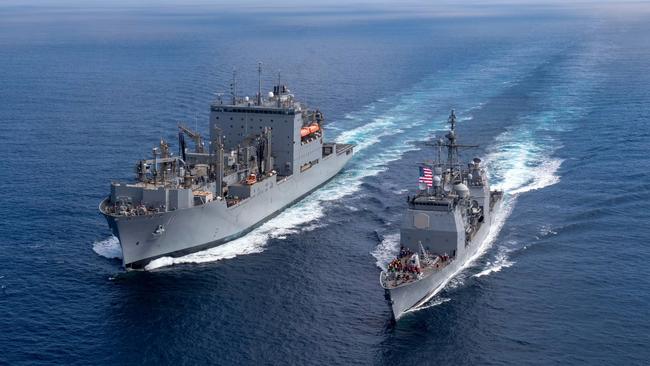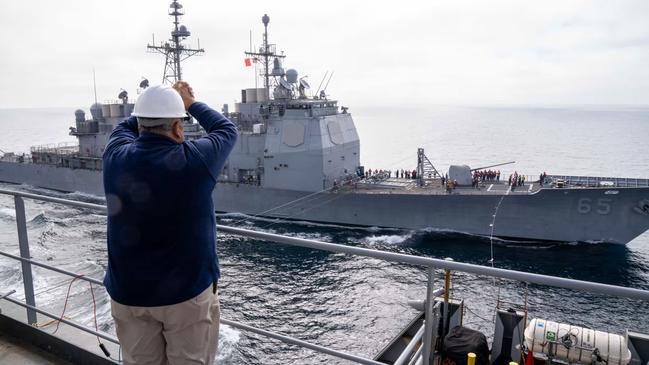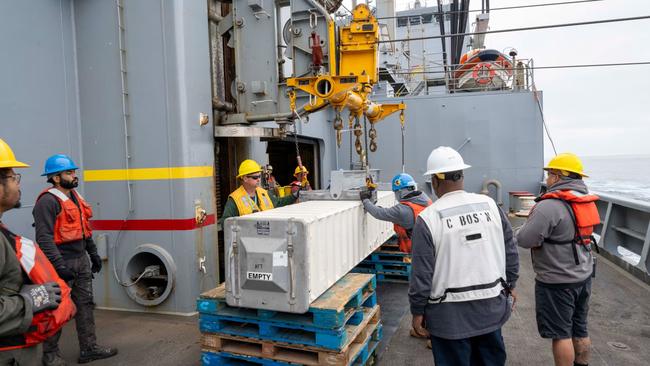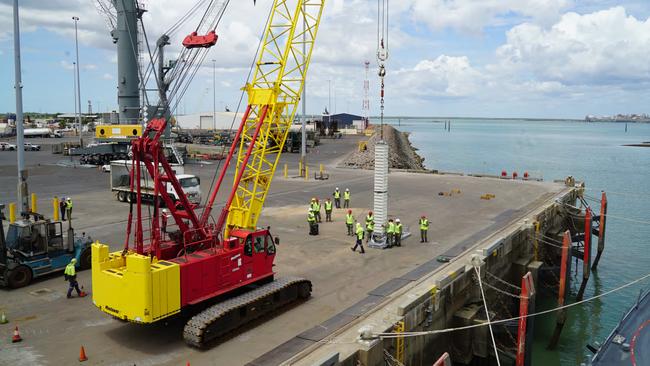China tensions prompt US Navy race to reload missiles at sea
Rearming destroyers can take them out of combat for two months. The US wants to fix that.

A US Navy destroyer can fire dozens of cruise missiles within minutes. Reloading the deadly warship back in port can take two months. In a war against China, that could be a fatal weakness.
To overcome the delay, Navy engineers pulled a 30-year-old crane out of storage, wired it up to computers, and used it to build a new prototype reloading system called the Transferrable Reload At-sea Method. TRAM, as it is known, promises to slash the time needed for missile reloading, potentially to just days.
“The ability to rearm at sea will be critical to any future conflict in the Pacific,” said Navy Secretary Carlos Del Toro after a recent test of TRAM off the California coast, to which The Wall Street Journal was granted exclusive access.
Until recently, the Navy didn’t feel much need for speed in rearming its biggest missile-firing warships. They only occasionally launched large numbers of Tomahawk cruise missiles or other pricey projectiles.
Now, Pentagon strategists worry that if fighting broke out in the western Pacific -- potentially 5000 miles (8000km) from a secure Navy base -- destroyers, cruisers and other big warships would run out of vital ammunition within days, or maybe hours.

Seeking to plug that supply gap, Del Toro tasked commanders and engineers with finding ways to reload the fleet’s launch systems at remote ports or even on the high seas. Otherwise, US ships might need to sail back to bases in Hawaii or California to do so -- putting them out of action for weeks.
Slow reloading has been causing the Navy headaches in the Red Sea. Warships deployed there to defend cargo ships from Houthi rebels in Yemen must sail through the Suez Canal and to ports in Greece or Spain to reload, leaving the fight for extended periods.
“We should have developed this capability fully decades ago,” said retired Navy Admiral James Stavridis. “Again and again, after firing a significant load of Tomahawks...I had to pull my warships off the line to rearm,” said Stavridis, a former Supreme Allied Commander Europe of the North Atlantic Treaty Organisation.
The Navy only reloads the launchers from solid ground or in sheltered harbours because it is a delicate operation. Engineers in the 1990s proposed systems for reloading at sea, but available technology wasn’t precise enough to transfer missiles from a platform constantly in motion, such as a ship or floating dock.
The US’s inability to restock missile launchers at sea is notable because America long ago performed engineering feats such as linking spacecraft orbiting the moon. The military routinely refuels military planes soaring above the clouds.
Engineers say that the ocean surface -- while more familiar -- presents uniquely vexing physics challenges due to currents, wind and the mix of air and water.
Now digital advances including 3-D printing, specialised radar and motion-detectors of the kind found in cellphones, have allowed the Navy to revisit the idea. Newfound urgency is speeding up work toward a solution.
“We are transforming the way we fight,” said Del Toro on-board the USNS Washington Chambers, a supply ship, during the TRAM test.

He watched as crews zip-lined a dummy missile container to the cruiser USS Chosin sailing alongside and as technicians operated the experimental crane to position the 20-foot-long box over the ship’s launch cells.
Del Toro, whose term ends with the Biden administration, wants equipment like TRAM included in ship modernisation work planned over the coming years.
Today, the only US warships that can be sustained indefinitely at sea and continue fighting are its 11 nuclear-powered aircraft carriers and nine smaller amphibious assault ships, none of which carry vertical missile silos.
TRAM could increase that number roughly fivefold, taking the total to around 100 warships without building a single new hull.
Until then, the Navy is seeking new rearming sites at friendly ports. In September, US sailors and logisticians for the first time reloaded a missile on-board the USS Dewey, a destroyer, at an allied naval base in Darwin, Australia.
At the Dewey’s deployment base in Yokosuka, Japan, missiles are reloaded from a barge that meets the destroyer at an anchorage in the harbour, but it is a sheltered area and the waters are calm. In a war, ports the US uses in Japan and Guam could be targeted by Chinese missiles, prompting the Navy to seek havens further away.
“If conflict were to erupt, or if something were to happen, being able to go to various different locations around the Indo-Pacific, it makes it much faster for us to reload,” said Cmdr. Nicholas Maruca, the Dewey’s captain.
From the South China Sea, Darwin is a roughly 4½-day journey under normal sailing conditions, compared with a roughly three-week journey to the US West Coast.
Reloading at sea could slash that downtime even further, but it would be a dicey operation. Missiles in their boxes, which resemble slender shipping containers, can weigh more than 6000lbs (2700kg). They must slide smoothly into tightfitting launch cells because jostling could damage delicate guidance systems -- or worse.

“These are supersonic rockets. There is a lot of fire and gas involved with this,” Maruca said. “If you drop the missile, that’s not good.” For decades, the Navy has provisioned its ships on the high seas by sending basic supplies across cables strung between them. It routinely refuels ships using hoses supported in this way.
The connections require the ships to sail at nearly identical speeds, maintaining a constant distance. The equipment is designed so connections can be severed instantly if needed, such as if attacked.
Loading a warship with dozens of missiles using a crane on the supply ship would be dangerously slow. TRAM is designed to make the process faster and safer.
Creating the TRAM mechanism was still challenging. To start work, Navy experts early this year pulled the mothballed 1990s prototype out of storage, disassembled it and drafted digital plans to reverse-engineer it, with help from some archived drawings.
Putting the new plans in a computer simulation, they located the mechanism’s weakest points and added about 300lbs. of steel reinforcement, said Ryan Hayleck, the project’s technical leader. The Chosin’s deck also needed reinforcing to handle the new load.
Technicians wired up both ships and the crane with sensors to understand how all the elements moved and what stresses they faced, all with the aim of refining designs. Navy Chief Engineer Rear Admiral Peter Small said the scads of data couldn’t have been collected through land-based tests and will guide the next steps.
“It’s safe to say that the TRAM of today is not your TRAM of yesteryear, ” said Del Toro.
The Wall Street Journal


